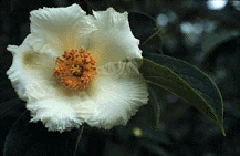| Stewartia ovata | |
|---|---|
 | |
| Flower | |
| Scientific classification | |
| Kingdom: | Plantae |
| Clade: | Tracheophytes |
| Clade: | Angiosperms |
| Clade: | Eudicots |
| Clade: | Asterids |
| Order: | Ericales |
| Family: | Theaceae |
| Genus: | Stewartia |
| Species: | S. ovata |
| Binomial name | |
| Stewartia ovata | |
 | |
| Range | |
| Synonyms [3] | |
| |
Stewartia ovata, known commonly as mountain camellia, [4] is a small tree native to low to mid-elevations in the southern Appalachian Mountains and nearby regions from Mississippi to Virginia. It is a member of the Theaceae, the tea family.
Contents
Although not endangered, the plant does have a limited range and is uncommon throughout its range. Mountain camellia grows in the understory of predominantly hardwood forests and tends to be found near streams, usually at elevations below 800 m (2,600 ft).

